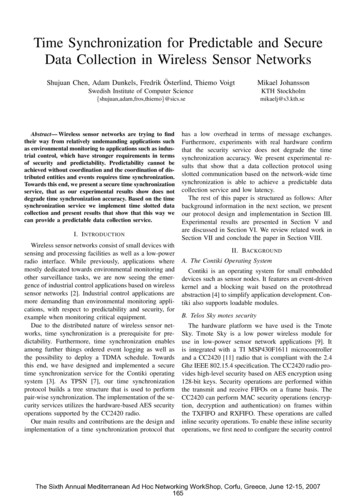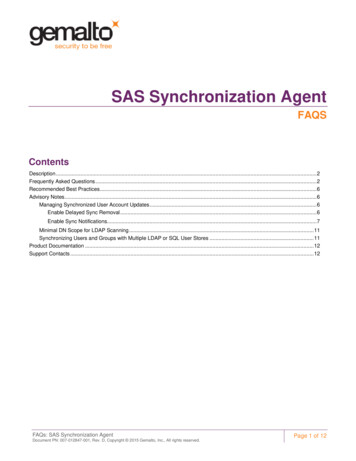
Transcription
Time Synchronization for Predictable and SecureData Collection in Wireless Sensor NetworksShujuan Chen, Adam Dunkels, Fredrik Österlind, Thiemo VoigtMikael JohanssonSwedish Institute of Computer ScienceKTH @s3.kth.seAbstract— Wireless sensor networks are trying to findtheir way from relatively undemanding applications suchas environmental monitoring to applications such as industrial control, which have stronger requirements in termsof security and predictability. Predictability cannot beachieved without coordination and the coordination of distributed entities and events requires time synchronization.Towards this end, we present a secure time synchronizationservice, that as our experimental results show does notdegrade time synchronization accuracy. Based on the timesynchronization service we implement time slotted datacollection and present results that show that this way wecan provide a predictable data collection service.I. I NTRODUCTIONWireless sensor networks consist of small devices withsensing and processing facilities as well as a low-powerradio interface. While previously, applications wheremostly dedicated towards environmental monitoring andother surveillance tasks, we are now seeing the emergence of industrial control applications based on wirelesssensor networks [2]. Industrial control applications aremore demanding than environmental monitoring applications, with respect to predictability and security, forexample when monitoring critical equipment.Due to the distributed nature of wireless sensor networks, time synchronization is a prerequisite for predictability. Furthermore, time synchronization enablesamong further things ordered event logging as well asthe possibility to deploy a TDMA schedule. Towardsthis end, we have designed and implemented a securetime synchronization service for the Contiki operatingsystem [3]. As TPSN [7], our time synchronizationprotocol builds a tree structure that is used to performpair-wise synchronization. The implementation of the security services utilizes the hardware-based AES securityoperations supported by the CC2420 radio.Our main results and contributions are the design andimplementation of a time synchronization protocol thathas a low overhead in terms of message exchanges.Furthermore, experiments with real hardware confirmthat the security service does not degrade the timesynchronization accuracy. We present experimental results that show that a data collection protocol usingslotted communication based on the network-wide timesynchronization is able to achieve a predictable datacollection service and low latency.The rest of this paper is structured as follows: Afterbackground information in the next section, we presentour protocol design and implementation in Section III.Experimental results are presented in Section V andare discussed in Section VI. We review related work inSection VII and conclude the paper in Section VIII.II. BACKGROUNDA. The Contiki Operating SystemContiki is an operating system for small embeddeddevices such as sensor nodes. It features an event-drivenkernel and a blocking wait based on the protothreadabstraction [4] to simplify application development. Contiki also supports loadable modules.B. Telos Sky motes securityThe hardware platform we have used is the TmoteSky. Tmote Sky is a low power wireless module foruse in low-power sensor network applications [9]. Itis integrated with a TI MSP430F1611 microcontrollerand a CC2420 [11] radio that is compliant with the 2.4Ghz IEEE 802.15.4 specification. The CC2420 radio provides high-level security based on AES encryption using128-bit keys. Security operations are performed withinthe transmit and receive FIFOs on a frame basis. TheCC2420 can perform MAC security operations (encryption, decryption and authentication) on frames withinthe TXFIFO and RXFIFO. These operations are calledinline security operations. To enable these inline securityoperations, we first need to configure the security controlThe Sixth Annual Mediterranean Ad Hoc Networking WorkShop, Corfu, Greece, June 12-15, 2007165
registers. Then we set the keys for transmission andreceiving. For counter-mode operations, we also needto set up the nonces (numbers used once) for eachtransmission and reception. After these settings, we canadd the security operations in the CC2420 MAC driverfor each transmission and reception [11].C. Time synchronization protocolsAccording to the varying requirements, such as diverse precision requirements, network density, degreeof mobility and topology stability, there exist severaltime synchronization protocols. Time synchronizationis typically based on message exchange containing thetimestamp and the measurement of delay. There are threebasic solutions for synchronization between two nodes:1) sender/receiver-based synchronization2) receiver/receiver-based synchronization3) delay measurement synchronizationOne-way message exchange is commonly used inreceiver/receiver synchronization solutions such as inthe Reference Broadcast Synchronization (RBS) [5],while a two-way message exchange is typically usedin sender/receiver-based synchronization solutions, suchas the Timing-sync Protocol for Sensor Networks(TPSN) [7]. There are also some synchronization protocols based on one-way message exchange as wellas the measurement of delay. An example of such aprotocol is Delay Measurement Time Synchronization(DMTS) [10].III. D ESIGN AND I MPLEMENTATIONIn this section we present the design and implementation of our time synchronization protocol and thepredictable data collection scheme.A. Time synchronizationAccording to Sundararaman et al. [1], TPSN achievesa good compromise between communication overhead,synchronization precision and computational complexity.DMTS has the advantage of low computational complexity and extremely low communication, but lowersynchronization precision compared to TPSN due tomore uncertainty from delay factors. RBS obtains highsynchronization precision at the expense of high communication overhead, computational complexity, and thedisadvantage that reference nodes are not synchronized.Based on Sundararaman’s comparison, we take theidea of TPSN [7] to achieve the good trade-off among theperformance metrics. Using implicit topology formationin our protocol design instead of the two-phase approachtaken by TPSN that explicitly establishes a hierarchicaltree in the first phase, we expect that our protocolachieves lower computational requirements and bettermobility support than TPSN while maintaining the sameperformance in other metrics. The main features of oursolution are:a) Pair-wise time synchronization: Figure 1 showsthe sender/receiver-based pairwise synchronization. LetT 0 be the client node (sender) timestamp on the requestmessage, T 1 the parent node (receiver) timestamp atarrival, T 2 the parent timestamp on departure of the replymessage and T 3 the client timestamp at arrival.Fig. 1.Sender/receiver-based pairwise synchronizationAssuming that both one-way delays are equal, we cancalculate the clock offset and the roundtrip delays asof f set [(T 1 T 0) (T 2 T 3)]/2,delay (T 3 T 0) (T 2 T 1).Knowing all the timestamps, the client (sender) decrements its logical clock by the estimated offset to achievesynchronization with the parent node. The delay information is necessary to prevent certain attacks asdescribed in Section IV.b) Application-level time synchronization: For ourimplementation we have decided to deploy applicationlevel time synchronization with time stamping at theMAC layer. By offering an application-level time synchronization service we can reduce the degree of coupling between service and MAC layers: the service isnot based on the specific MAC protocol but on theinterface at the application level. Meanwhile, we canstill timestamp the packet at the MAC layer to reduceuncertainty from varying software stack processing time.c) Network-wide time synchronization: To achievenetwork wide time synchronization, we implicitly establish a hierarchical tree over the network with the rootnode as time reference node. Then we perform pairwisetime synchronization along the tree as shown in Figure 2.The Sixth Annual Mediterranean Ad Hoc Networking WorkShop, Corfu, Greece, June 12-15, 2007166
To form a hierarchical tree, all sync packets containa hopcount. When a node receives a sync message, itchecks the hopcount of the sender. If its own hopcountis greater than the sender’s hopcount plus one, it updatesits hopcount and sets its parentID to be this sender’sID. In this way, the hierarchical tree can be constructedimplicitly and adapt dynamically to topology changes.We assume that only the sink node has the right to initialize a network-wide synchronization. Its network synchronization message NETSYNC BROADCAST triggers the nodes to start a new round of synchronization. The sink node sends the message NETSYNC BROADCAST periodically to achieve a periodical resynchronization of the network. We need to perform periodical synchronization because the clock mightlose synchronization due to crystal frequency differenceor clock drift caused by environmental conditions suchas the temperature.Sink32 321L11L122’1: NETSYNC BROADCAST2: PSYNC REQUEST2’: PSYNC REQUEST (overheard)3: PSYNC ACKL2Fig. 2.network-wide time synchronizationWhen nodes at level 1 get the NETSYNC BROADCAST message from the sink node,they update their hopcount and parentID, wait a randomdelay (to avoid collisions with other nodes in the samelevel), and then send the PSYNC REQ to the sink nodeto start the pairwise synchronization. Nodes in lowerlevels overhear the PSYNC REQ from their parents,wait an estimated roundtrip delay (to allow the parentto finish synchronizing) plus a random delay (to reducecollisions with nodes on the same level) and then triggertime synchronization by sending a PSYNC REQ.When receiving a PSYNC REQ message addressed toit, a node immediately returns a PSYNC ACK messageto the requesting node. The timestamp of sending and receiving a PSYNC REQ is included in the PSYNC ACKmessage and send back to the requesting node.When receiving a PSYNC ACK message, the noderecords the receiving and sending timestamp of thePSYNC ACK message. At that point, the node has thefour required timestamps and can synchronize its clockto its parent as described above.B. Predictable data collection with low latencyFor control applications data collection with predictable latency is of crucial importance. In this sectionwe present a multi-hop low latency data collection protocol based on Treeroute, one of the convergecast protocolsimplemented in Contiki.The treeroute routing protocol is based on Trickle[8], a flooding protocol, originally intended for codepropagation in sensor networks. Once one node is setas the sink, it sends the trickle routing broadcast withhopcount 0. When a neighboring node receives thisbroadcast it checks if its hopcount is equal to one. If not,it updates its neighbor table and changes its hopcount toone. Then it waits a random delay and send a new routingbroadcast with its hopcount to inform the neighboringnode in next level to update their hopcount and neighbortable. This process continues until all the nodes haveupdated their hopcount and neighbor table.At the same time, a node might also get the broadcastfrom the neighboring nodes in the same level or fromthe children in the next level, it might also add thesenodes into its neighbor table if the neighbor table has anneighbor entry with higher hopcount or same hopcountbut with lower signal strength. After this routing process,every node has a hopcount, representing its level inthe network, and a table of all its neighbors with goodconnectivity.Sensed data is forwarded from the sensor node to thesink along the routing path derived from the neighbortable in each node. Data packets are forwarded to thebest neighbor, i.e. the neighbor node with highest signalstrength of the ones that have the lowest hopcount. Tomaintain reliable communications, retransmissions witha maximum limit are carried out if an implicit ACK isnot recorded within a fixed period. An implicit ACK iswhen the sender overhears that the receiver forwards thesent packet, and is taken as an acknowledgement that thepacket has been received successfully.To achieve low-latency and reliable data collection,we must reduce collisions, thus reducing contention timeand the number of retransmissions. Based on our timesynchronization service, we deploy a TDMA scheme assigning different slots to each node. A sensor node sendsdata only in its slot and thus avoids collision with othernodes. In our data collection protocol, slot assignmentis done according to a time schedule constructed byThe Sixth Annual Mediterranean Ad Hoc Networking WorkShop, Corfu, Greece, June 12-15, 2007167
dividing one second into N slots and assigning one slotto each node according to its (unique) nodeid. In thisway, data collection becomes reliable and fast.IV. S ECURITY G OALS AND A NALYSISIn this section we present the main goals for the securetime synchronization and data collection services, discuss attack scenarios and implemented countermeasures.A. Secure time synchronizationWe have two main goals for the secure time synchronization service: First the protection of the critical data(i.e. the timestamps) from being modified and delayed.This is necessary to get the correct time offset for theclock correction. Second, we must prevent nodes fromsynchronizing to a malicious node in order to guaranteethat sensor nodes synchronize only to the legal nodesin the network. Next, we present a number of possibleattack scenarios and discuss to what extend our secureservice provides effective countermeasures.Modification of timestampsOne possible attack scenario is when an adversaryattempts to modify the values of the timestamps in syncpackets. This can be counteracted using cryptographicmethods, such as data authentication or encryption. Toprevent the modification, the timestamps in a sync packetare authenticated using CBC-MAC (Cipher Block Chaining Message Authentication Code) for authentication,hence there is no way to change the timestamps withoutbeing detected. A secret key is shared between the senderand receiver for the authentication.Pulse-delay attackAs described in [6], the pulse-delay attack can beperformed by jamming the initial pulse, storing it inmemory and then replaying it later at a arbitrary time. Bymanipulating the pulse-delay, an adversary can arbitrarilychange the computed time offset. Any delay attackswhich lead to delayed timestamping can be detectedby setting a threshold value according to the estimatedmaximum one-way transmission delay. A one-way transmission delay includes transmission processing time,media access time, propagation delay, and receivingprocessing time. A node calculates the round-trip delayin a pairwise synchronization. If the delay exceeds thethreshold value, it discards the packet.Replay attackA replay attack is when an adversary captures a packetand replays it at a later time. The old packet with an oldtimestamp leads to a false offset and could compromisethe time synchronization process. Replay attacks can bedetected by the authenticated timestamps or via sequencenumbers. A node maintains the value of last timestampor sequence number from its parent. When it receivesa broadcast from its parent, it checks if it is an oldmessage. If so, it regards it as a replay message andsimply discard it.Compromised nodesCompromised node attacks are common for wirelesssensor networks without physical security and couldallow an adversary to manipulate the compromised nodeto send false data. Resisting attacks from compromisednodes goes beyond the scope of cryptographic methodsand is currently not considered in our design.B. Security for low-latency data collectionThe main design goals for a secure low-latency protocol are the following: First, the data should be protected from being modified and disclosed by maliciousattackers. Second, we want to make sure the data packetsarrive at the destination node, i.e. the sink, with tolerablelatency. Finally, we want to ensure that data packets arenot the old ones replayed by an adversary.An adversary can easily modify the data if no authentication mechanism is used. If the data is confidential, itneeds to be encrypted to prevent disclosure. To protectthe data in transit, we propose to use the security modeCCM to encrypt and authenticate all data packets basedon a secret key shared by the sink and all sensor nodes.The latency for data collection using Treeroute depends on the hopcount of sender, i.e. the distance tothe sink, as well as the number of retransmissions. Anadversary might arbitrarily delay the data packets, but theretransmission mechanism according to the implicit ACKin Treeroute will, to some extent, counter this attack. Ifthe sender does not receive the implicit ACK in a shortperiod, it regards it to be lost and retransmit it. Aftera maximum number of retransmissions, a node removesthis neighbor and finds another forwarding node.Replay attacks can also happen. If the data packetcontains data about a time-critical event, it should not bereported repeatedly to trigger a false alarm. So sequencenumbers can be used in each packet for each sensornode. The sink node needs to keep track of the lastsequence number of data from each node. When thereplayed packet is received, the sink node discards it.As an alternative, the authenticated timestamp can alsobe used to ensure data freshness.V. E XPERIMENTAL E VALUATIONIn this section we evaluate our protocols by conductingexperiments on real hardware using the Contiki operatingThe Sixth Annual Mediterranean Ad Hoc Networking WorkShop, Corfu, Greece, June 12-15, 2007168
system. For all experiments we set the tick frequency to512, i.e. one tick equals 1/512 second 2 milliseconds.A. Time Synchronization Accuracy1) Synchronization without security: In this part, wedisable the security operations for all communications,so the time synchronization is not protected. Elevennodes are deployed for the experiments, respectively,running in a single-hop fashion and a multi-hop fashion.a) Single-hop networks: In a single-hop network,one node acts as the sink node and initiates the networkwide time synchronization. The remaining ten nodessynchronize themselves to the sink node. The topologyis shown in Figure 3.Fig. 3.Fig. 4.Synchronization in a single-hop network without securityb) Multi-hop networks: To evaluate the synchronization performance in a multi-hop network, we placetwelve sensor nodes in a configuration where threemonitored nodes are three hops away from the sink, seeFigure 5. We record the results for three nodes in level 3for 50 rounds of periodical synchronization and analysethe synchronization error between these three nodes andtheir parent node. The results are shown in Figure 6.Single-hop network topologyThe main problem here is that all neighboring nodesneed to send the requests (PSYNC REQ) at differenttimes in order to avoid collisions after receiving theNETSYNC BROADCAST message from the sink atthe same time. So a random delay is used for theneighboring nodes to send the request at a different time.We set the maximum random delay as: random delay max num round delay f a, where f a a factor thatadjusts the collision probability. In this experiment, letmax num to be 10, round delay to be 6, and f a to be10. Thus the maximum random delay is 600 (ticks).All nodes run the time synchronization process andone node as acts the sink, periodically initiating time synchronization by sending the NETSYNC BROADCASTmessage. In our experiment, we record the results for 50periodical synchronizations for the sink node and threeneighboring nodes. The results shown in Figure 4 showsthat the three nodes achieve synchronization with anaverage synchronization error of 1.4 ticks. Meanwhile,the sink node receives about 97.6% of requests fromthe neighboring nodes. That is, only about 2.4% of therequests are lost due to collisions.Fig. 5.Multi-hop network topologyThe results in the figure show that the three nodesachieve synchronization with an average synchronizationerror of 1.1 ticks. The average synchronization erroris lower than that of the previous test in a single-hopnetwork. This is reasonable since only three nodes inthe same neighborhood synchronize to the same parent.In contrast, in the single-hop network, ten neighboringnodes are synchronizing with their parent, the sink node.Thus the chance of collision between the neighboringnodes is much higher and leads to more uncertainty inthe time-critical path for the single-hop experiment.2) Synchronization with security: In this part, weenable the MAC-layer security operations to protectThe Sixth Annual Mediterranean Ad Hoc Networking WorkShop, Corfu, Greece, June 12-15, 2007169
Fig. 6.Synchronization in a multi-hop network without securitythe time synchronization process. The same networktopologies as above is used for the experiments. In theexperiment, we choose the authentication mode, CBCMAC with 128-bit MIC, to protect the timestamps forsynchronization from illegal modification. We do not usethe encryption mode because we are not concerned ifthe timestamps are captured by an adversary but only ifthe timestamps are changed in transit. The MAC-layersecurity operation is transparent to the protocol, but itcan detect the modification of data packet and discardthe packet if the packet does not pass the MIC check.a) Single-hop networks: For a single-hop networkrunning with security, we record 50 rounds of periodicalsynchronization for three nodes synchronizing with thesink node. The results are shown in Figure 7.Fig. 8.Synchronization in a multi-hop network with securityerror of 1.0 ticks. Without security, the average error was1.1 ticks. Also here, the difference to the results withoutsecurity is 0.1 ticks which we consider to be a statisticalerror.In the experiments, our time synchronization protocol achieves network-wide synchronization with synchronization error of about 1 to 2 ticks, i.e., 2 to4 milliseconds. Moreover, synchronization with MAClayer security works as well as synchronization withoutsecurity. The time for security operation on a fixedlength of synchronization packet should be deterministic. Hence, and as confirmed by our experiments, thesynchronization error is not affected by the MAC-layersecurity operation.B. Time-synchronized low-latency data collectionIn this section, we conduct experiments to measure theend-to-end latency for data packets sent between sensornodes and the sink node in the network. The networksetup is shown in Figure 9.Fig. 7.Synchronization in a single-hop network with securityFigure 7 shows that the three nodes achieve synchronization with an average synchronization error of 1.5ticks. Without security this error was 1.4 ticks.b) Multi-hop networks : In the multi-hop scenario,we record 50 rounds of periodical synchronization forthe three nodes synchronizing with its parent node. Thesethree nodes are located in level 3 (i.e., 3 hops away fromthe sink node). The results are shown in Figure 8.Figure 8 shows that the three nodes achieve synchronization to their parent with an average synchronizationFig. 9.Network for data collection experimentEach node is assigned a unique slot during a slotperiod. Since each slot period is 32 ticks (around 64ms), we can assign 16 slots per second.The Sixth Annual Mediterranean Ad Hoc Networking WorkShop, Corfu, Greece, June 12-15, 2007170
We run a data collecting application based on timesynchronization providing a global clock and Treerouteproviding multi-hop routing. After the sensor nodessynchronize with the network, they send one data packetevery second. The latency is measured for each datapacket in ticks. In the sink node, we collect 5000 datapackets from both one-hop nodes and two-hop nodes.Figure 10 shows the latency for packet delivery fromone-hop nodes. The average end-to-end latency for onehop data collection is 5.3 ticks (close to the single-hopcommunication latency for an isolated pair of nodes).Figure 11 shows the latency for data delivery from twohop nodes. The average end-to-end latency for two-hopdata collection is 10.3 ticks.Fig. 10.Latency statistics in from one-hop nodesFig. 11.Latency statistics in from two-hop nodesThe results show that the latency increases with thenumber of hops from the sink. The latency is stable so wecan conclude that the sensor nodes are stably synchronized and collisions are eliminated by the schedule-basedslotted data communication.VI. D ISCUSSIONIn this section we discuss problems caused by nodefailure or isolation. In a WSN, a node can die due toenergy exhaustion or other interruption. Nodes can alsobe isolated from the network due to radio instability.a) Node isolation: During our experiments weobserved that a sensor node at level n occasionallyoverheard the timesync request from a node at level n2, i.e. the parent’s parent, and updated its hopcount ton-1. The problem is that this is just an occasional eventcaused by the fact that communication quality in wirelesssensor networks can vary dramatically over time [12] andthe node may never be able to overhear from that nodeagain. Meanwhile the node ignores timesync requestfrom node at the same level, n-1. In this case, the nodewill wait infinitely for the message from level n, but infact it is too far to get timesync request again. As a resultthis node will be isolated from the time synchronizationprocess.To reduce the occurrence of this situation, we can seta threshold value of the signal strength of the timesyncpackets. Only if the signal strength of the receivedtimesync packet is greater than the threshold value,the node will handle this packet and simply discard itotherwise. Another possibility is to define a timeout foreach node. The timer will be reset every time a pairwisesynchronization is done. If the timer times out, the nodeaccepts timesync packet from other nodes and selects anew parent. This way an isolated node can get the chanceto synchronize to the network with a new parent.b) Node failure: This problem occurs when a nodefails due to energy exhaustion or other unexpected interference. If the node is a leaf node this will not affectthe time synchronization. But if the node is the parentof other nodes, then all its children will be isolated fromthe network. Also this problem can be solved using atimer. Each node checks if a timeout period has passedwithout any message from its parent node. If the timerexpired, the node regards its parent as dead and updatesits hopcount when getting message from other node. Inthis case, it might also get the message from nodes atthe next level or the same level, but according to therule, it will keep updating its hopcount until it gets themessage from the neighbour node the highest level. Inboth cases, the value of the timeout period needs to beset properly according to the network synchronizationperiod. It should be at least greater than one networksynchronization period. In the current implementation,we set the time out period to be five times of networksynchronization period.VII. R ELATED W ORKIn Reference Broadcast Synchronization (RBS) a reference node broadcasts a message and all the nodesin coverage will timestamp the local time of receivingThe Sixth Annual Mediterranean Ad Hoc Networking WorkShop, Corfu, Greece, June 12-15, 2007171
this reference message [1], [5]. Nodes then exchangethe recorded times to gain knowledge of the time offsetbetween themselves and other nodes in the network.RBS avoids the largest sources of error (send time andmedia access time) in the time-critical path and thesynchronization error depends only on the difference inpropagation time (often negligible), the time differencebetween receivers and the radio synchronization error,which is typically a few microseconds. In contrast toRBS, our protocol expects lower computational complexity and synchronizes the whole network includingthe reference node. In the time-critical path, if mediaaccess time and transmission time are deterministic,our protocol can expect an equivalent synchronizationprecision as in RBS. The precision difference to RBSwill depend on the uncertainty of transmission time andmedia access time in the time-critical path.The Timing-sync Protocol for Sensor Networks(TPSN) aims at providing network-wide time synchronization and establishing a unique global timescale bycreating a self-configuring hierarchical tree. TPSN hastwo phases to achieve network-wide synchronization: thelevel discovery phase and the synchronization phase. Inthe level discovery phase a hierarchical tree is established. In the synchronization phase, pair-wise synchronization is performed along the edge of the tree. Thesynchronization accuracy does not degrade significantlywith the number of nodes in the network, so the protocolis scalable, but due to its dependence on the hierarchicalinfrastructure, TPSN is not suitable for highly dynamicnetworks with mobile nodes [1], [7]. In contrast toTPSN, our protocol can expect lower communicationoverhead and better adaptability to topology changesthrough the dynamic implicit tree formation while maintaining an equivalent synchronization precision. Thesynchronization precision in our protocol depends onthe uncertainty of the same factors as in TPSN, i.e.,media access time, transmission time, propagation timeand reception time in the time-critical path.Delay Measurement Time Synchronization (DMTS)is very energy-efficient and computationally lightweightsince it needs only one time broadcast to synchronizeall the nodes in a single-hop network. The receiversmeasure the time delay and set their time as the sender’ssending timestamp plus measured time transfer delay.The synchronization
B. Predictable data collection with low latency For control applications data collection with pre-dictable latency is of crucial importance. In this section we present a multi-hop low latency data collection proto-col based on Treeroute, one of the convergecast protocols implemented in Contiki. The treeroute routing protocol is based on Trickle










